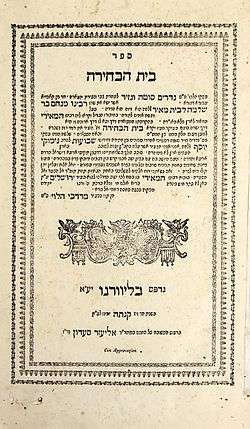Menachem Meiri
| Menachem Meiri | |
|---|---|
| Personal details | |
| Born |
1249 Perpignan, Catalonia, Provence |
| Died |
1306 Perpignan, Catalonia |
Menachem ben Solomon Meiri or Hameiri (1249–1306) was a famous Catalan rabbi, Talmudist and Maimonidean.
Early life
Menachem Meiri was born in 1249 in Perpignan, which then formed part of the Principality of Catalonia. He was the student of Rabbi Reuven, the son of Chaim of Narbonne, France.
Beit HaBechirah

His commentary, the Beit HaBechirah (literally "The Chosen House," a play on an alternate name for the Temple in Jerusalem, implying that the Meiri's work selects specific content from the Talmud, omitting the discursive elements), is one of the most monumental works written on the Talmud. This work is less a commentary and more of a digest of all of the comments in the Talmud, arranged in a manner similar to the Talmud—presenting first the mishnah and then laying out the discussions that are raised concerning it.[1] Prof. Haym Soloveitchik describes it as follows:[2]
- Meiri is the only medieval Talmudist (rishon) whose works can be read almost independently of the Talmudic text, upon which it ostensibly comments. The Beit ha-Behirah is not a running commentary on the Talmud. Meiri, in quasi-Maimonidean fashion, intentionally omits the give and take of the sugya, he focuses, rather, on the final upshot of the discussion and presents the differing views of that upshot and conclusion. Also, he alone, and again intentionally, provides the reader with background information. His writings are the closest thing to a secondary source in the library of rishonim.
Unlike most rishonim, he frequently quotes the Jerusalem Talmud, including textual variants which are no longer extant in other sources.
Beit HaBechirah cites many of the major Rishonim, referring to them not by name but rather by distinguished titles. Specifically:[3]
- Gedolei harabbanim - Rashi
- Gedolei hamefarshim - Raavad (or Gedolei hamegihim when quoted as disputing Rambam or Rif)
- Gedolei haposkim - Isaac Alfasi
- Gedolei hamechabrim - Rambam
- Geonei Sefarad - Ri Migash
- Hachmei HaTzarfatim - Rashbam
Historical impact
A complete copy of Beit HaBechira was preserved in the Biblioteca Palatina in Parma, rediscovered in 1920, and subsequently published.[4] Much of Beit HaBechirah was published long before the publication of the Parma manuscripts.[4] Nevertheless, the common perception has been that the Meiri's works were not available to generations of halachists before 1920; early 20th century authors such as Chafetz Chaim, Chazon Ish, and Joseph B. Soloveitchik write under the assumption that Beit HaBechira was newly discovered in their time.[4]
Beit HaBechira has had much less influence on subsequent halachic development than would have been expected given its stature. Several reasons have been given for this. Some modern poskim refuse to take its arguments into consideration, on the grounds that a work so long unknown (in their opinion) has ceased to be part of the process of halachic development.[4] One source held that the work was ignored due to its unusual length.[4] Professor Haym Soloveitchik, though, suggested that the work was ignored due to its having the character of a secondary source - a genre which, he argues, was not appreciated among Torah learners until the late 20th century.[5][2]
Other works
Menachem Meiri is also noted for having penned a famous work used to this very day by Jewish scribes, namely, Kiryat Sefer, a two-volume compendium outlining the rules governing the orthography that is to be adhered to when writing Torah scrolls.[6]
He also wrote several minor works, including a commentary to Avot whose introduction includes a recording of the chain of tradition from Moses through the Tanaim.
Halakhic positions
Meiri's commentary is noted for its position on the status of gentiles in Jewish law, asserting that discriminatory laws and statements found in the Talmud only applied to the idolatrous nations of old.[7][8]
See also
References
- ↑ Jewish History - Biographies, letter R
- 1 2 Rupture and Reconstruction: The Transformation of Contemporary Orthodoxy
- ↑ https://he.chabad.org/library/article_cdo/aid/3334259
- 1 2 3 4 5 http://kotzkblog.blogspot.com/2017/01/112-meiri-texts-lost-or-ignored.html
- ↑ Soloveitchik (1994), p. 335; note 54, p. 367f.
- ↑ Two editions of this work were printed in Jerusalem, one in 1956, another in 1969.
- ↑ Moshe Halbertal. "'Ones possessed of religion': religious tolerance in the teachings of the Me'iri" (PDF). The Edah Journal. 1 (1).
- ↑ David Goldstein, "A Lonely Champion of Tolerance: R. Menachem ha-Meiri's Attitude Towards Non-Jews"
Bibliography
- Soloveitchik, Haym (1994). "Rupture and reconstruction: the transformation of contemporary orthodoxy". Tradition. 28 (4): 320–376.